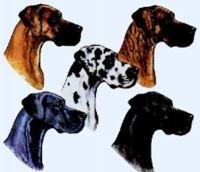Dane Standard
 As forerunners of the present day Great Dane, one must look at the old Bullenbeisser (Bulldog) as well as the Hatz-and Saurden (Hunting and wild boar hounds), which were midway between the strong Mastiff of English type and the fast, handy Greyhound.
As forerunners of the present day Great Dane, one must look at the old Bullenbeisser (Bulldog) as well as the Hatz-and Saurden (Hunting and wild boar hounds), which were midway between the strong Mastiff of English type and the fast, handy Greyhound.
The term Dogge was at first understood to mean a large, powerful dog, not of any particular breed. Later, particular names such as Ulmer Dogge , English Dogge, Great Dane, Hatzrde (Hunting Dog), Saupacker (boarfinder) and Grosse Dogge (Great Dogge), classified these dogs according to colour and size.
In the year 1878 a Committee of seven was formed in Berlin, consisting of active breeders and judges with Dr. Bodinus in the chair, which made the decision to classify all the forenamed varieties as Deutsche Doggen (Great Danes).
Thus the foundation was laid for the breeding of a separate German breed. In the year 1880, on the occasion of a show in Berlin, the first standard for the Deutsche Dogge was laid down. This standard has been taken care of since the year 1888 by the Deutsche Doggen Club 1888 (German Doggen Club, registered Club 1888) and frequently been revised over the years. The present Standard meets the requirements of the F.C.I.